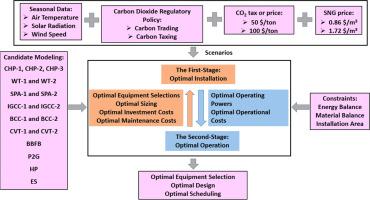A two-stage stochastic MINLP model to design and operate a multi-energy microgrid by addressing carbon emission regulatory policies uncertainty
IF 3.9
2区 工程技术
Q2 COMPUTER SCIENCE, INTERDISCIPLINARY APPLICATIONS
引用次数: 0
Abstract
This study suggests a two-stage mixed-integer nonlinear programming model considering uncertainty related to implementation of carbon dioxide emission regulatory policies, which are carbon trading and emission taxing and can change over the years, for the purpose of optimal equipment selection from candidate equipment to design, size and operate a multi-energy microgrid. The uncertain sources are air temperature, wind speed, solar radiation, carbon dioxide trading price or tax, and natural gas price. Candidate equipment are wind turbines, PV arrays, a biomass-fired generator, biomass combined cycles, combined heat and power generators, conventional generators, an electricity storage unit, integrated gasification combined cycles, a heat pump, and a power-to-synthetic natural gas (P2G) system. Three case studies are investigated. In the first case, the model selects the optimal equipment for meeting the electricity and heat demands only. In the second case, the optimal equipment selections are determined to couple with the P2G system to meet the electricity, heat, and natural gas demands. In the third case, the model selects the optimal equipment to run with sustainable energy generators: wind turbines and solar panels. The optimal selections are compared between deterministic and stochastic forms of the optimization models.

基于碳排放监管政策不确定性的多能源微电网设计与运行两阶段随机MINLP模型
本研究提出了一种考虑二氧化碳排放监管政策(碳交易和排放税)实施的不确定性的两阶段混合整数非线性规划模型,用于从候选设备中选择最佳设备,以设计,规模和运行多能微电网。不确定的来源是气温、风速、太阳辐射、二氧化碳交易价格或税、天然气价格。候选设备有风力涡轮机、光伏阵列、生物质燃烧发电机、生物质联合循环、热电联产发电机、传统发电机、电力存储单元、综合气化联合循环、热泵和电力合成天然气(P2G)系统。调查了三个案例研究。在第一种情况下,模型只选择满足电力和热量需求的最佳设备。在第二种情况下,确定了与P2G系统耦合的最佳设备选择,以满足电力、热量和天然气需求。在第三种情况下,该模型选择最佳设备来运行可持续能源发电机:风力涡轮机和太阳能电池板。比较了确定性优化模型和随机优化模型的最优选择。
本文章由计算机程序翻译,如有差异,请以英文原文为准。
求助全文
约1分钟内获得全文
求助全文
来源期刊

Computers & Chemical Engineering
工程技术-工程:化工
CiteScore
8.70
自引率
14.00%
发文量
374
审稿时长
70 days
期刊介绍:
Computers & Chemical Engineering is primarily a journal of record for new developments in the application of computing and systems technology to chemical engineering problems.
 求助内容:
求助内容: 应助结果提醒方式:
应助结果提醒方式:


